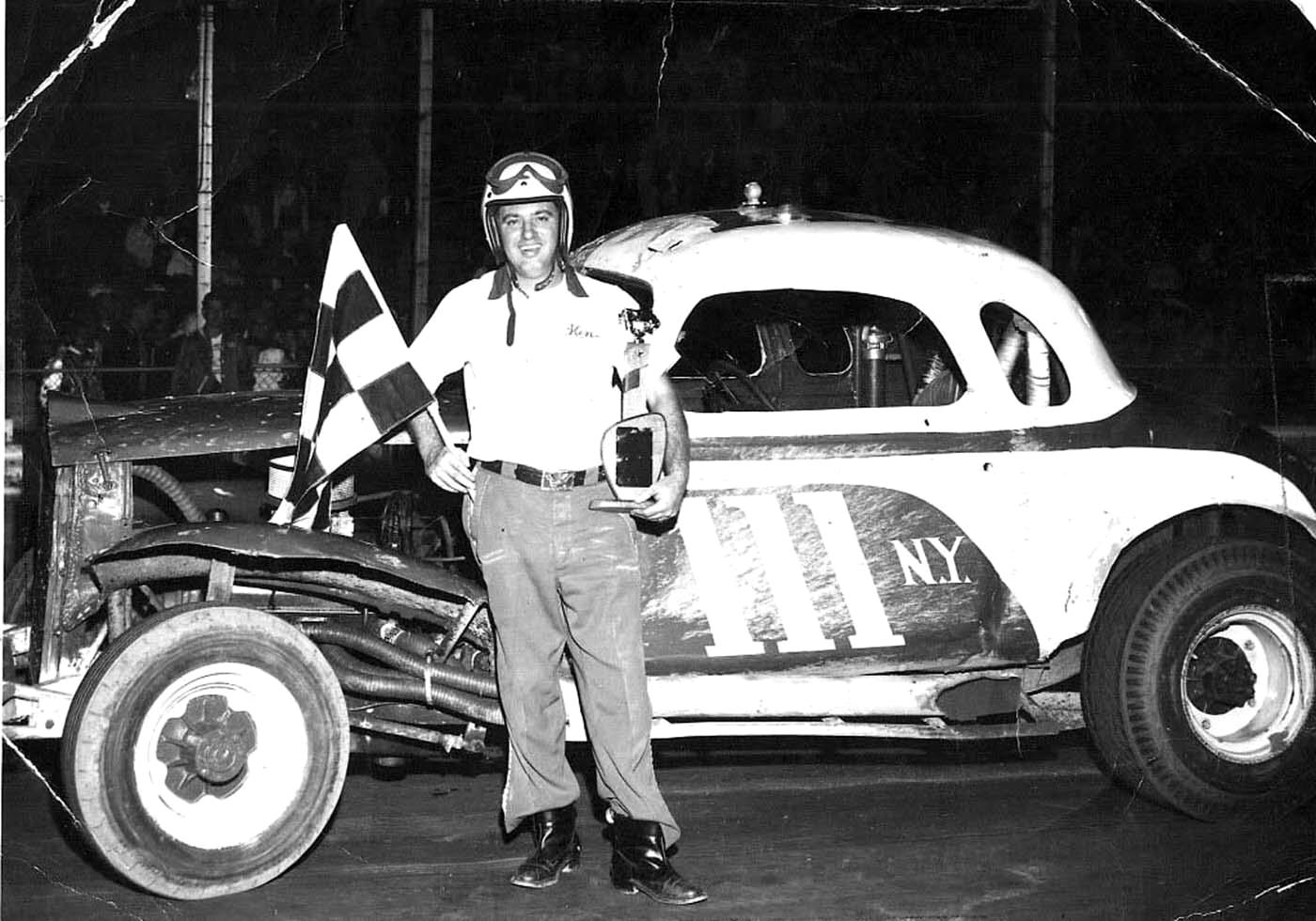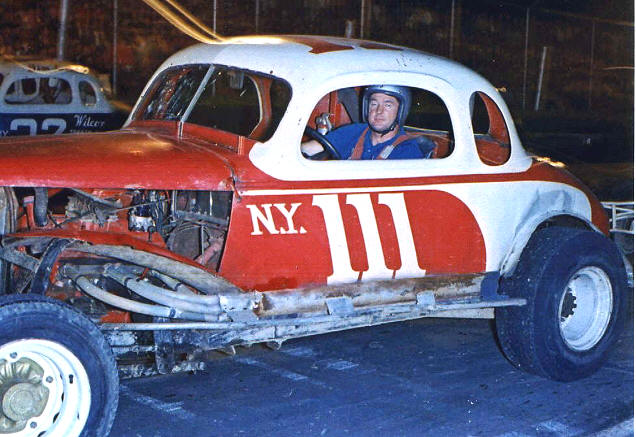|
|
Since I seem to have lost my forum, Mark
Thomas' "Racin' Paper", I will apparently enter the 21st Century and start doing
my column as a
blog. In certain times of the year, this may not be weekly; but I promise to
keep it regular. Many of the site regulars have only been able to
get my columns via this site, anyway, and representing the very newspaper that
was given out at Thunder Road gave me no press courtesies.
So, I might as well do it this way and reach some different readers. Let me know
what you think. -Bill
Week of August 20, 2012
|
|
THE SHORT – LIVED BUT FAMOUS RED & WHITE COUPES
One of the first times I ever saw one of the NASCAR – legal sportsman cars was at the old Otter Creek Speedway, in the town of Waltham, VT – just outside of Vergennes. The track, brand new at that time in 1961, was NASCAR – sanctioned and – therefore – was attractive to the high – performing New York state sportsman teams who were ranked high in the national standings in those days. 1961, it may be remembered, was the year Dick Nephew and Bill Wimble tied for the national championship; and the track was accessible to both teams.
Jeep Herbert, probably Caputo’s longest – tenured driver, poses with the what I believe to be the Plymouth coupe. Note future Herbert car owner Frank Trinkhaus with his ace wrench Norm House in the background. [Courtesy of Jo Towns, via Otto Graham]
During that brief, late – starting 1961 at Otter Creek, the class of the field was neither Wimble nor Nephew – it was a red and white 1936 Chevrolet coupe numbered 111 and driven by Kenny Shoemaker. Although, at that time, I had never been to Fonda, I had heard of the rotund, pugnacious Shoemaker from the lucky neighbors who did get to make the trip regularly. Shoemaker may have performed at the long – closed Pico Raceway, near Rutland, but I cannot recall hearing his name then.
The red and white cars, with the numbering preference always centered around some variation of 11 or 111, had a brief but colorful history, and their impact on racing in New York far outweighed the short time they were active on any track. The team was originally started by a Hudson Falls businessman named Henry Caputo. With his ace mechanic named Edwin “Shortstroke” Wright, Caputo proceeded to field two cars with distinctive red and white graphic schemes that would last through to the end of the team’s operation.
George Baumgardner, respendent with red satin racing pants, poses with the Plymouth which he would terminate at Otter Creek later. [Courtesy of Otto Graham]
Headquartered at Burgoyne Avenue, on the east side of Hudson Falls, Caputo apparently operated an automobile – related business that allowed his dalliance with motor racing to be conducted properly. The Caputo stable included [at one point or another] a 1936 Plymouth coupe [#11] and a couple of different Chevies that utilized 111 and 11.
The Caputo racing schedule was ambitious in the late 1950’s and into the very early ‘60’s, running a wide range of venues from as far north as Airborne Park Speedway, in Plattsburgh, NY to Stateline Speedway, near Bennington, VT. Caputo cars ran Fonda Speedway and – towards the end of the team’s life – they did venture all way up to Otter Creek Speedway briefly.
Tiger Tom Kotary, with a feature win at Fonda. It surely looks like this is the Caputo car
that ended up as that potent Drellos Shoemaker 111. [Ed Fuez Collection]
Caputo utilized an eclectic stable of drivers in his brief run as car owner: Rome, NY’s eccentric “Tiger Tom” Kotary, an unpredictable WWII vet who had driven for numerous owners; a hulking Glens Falls driver named Earl Maille, who drove the car at Fonda, among other venues; the diminutive Saratoga veteran chauffeur George Baumgardner, another lifelong rent – a driver; young Saranac Lake mopar enthusiast Jimmy Hoyt, who was drawn to the Plymouth – somewhat rare on the sportsman circuit then; Howard “Jeep” Herbert, another legend who almost never drove his own equipment; and others, who may have had very brief stints.
Jim Hoyt, with his personally – built Plymouth ironically leads a car 11. However, the 11 was
Junior Bruno, not a Caputo car. [Bob Mackey Photo Courtesy of John Rock]
The early 1960’s were not good to the Caputo team. Henry was going to run into serious legal problems [which I am sure he could see developing] and would eventually end up in prison. Baumgardner hit the infamous water that ran across Otter Creek Speedway’s fourth turn, lost control, had the nose of the Plymouth did into the track, and demolished the storied coupe. Although a second Chevy was constructed, the swan song of the Caputo team had arrived in the 1961 season.
When Caputo was going kaput-o, Hoyt and his even – younger friend Wes Moody, went down to Hudson Falls to buy the Plymouth [or what was left of it]. Hoyt’s father, in addition to building the Saranac Lake Speedway, was the local mopar dealer, and the family wanted that make of car to race at their rustic new track. Jim want on to say recently, that they found the Caputo Plymouth unsalvageable and they went to build Hoyt a beautiful Plymouth coupe that got numbered 5 ½, that being half of the Caputo car number.
Kenny Shoemaker in a very familiar spot at Fonda during his Drellos stint. This is likely the car that came over from Caputo and ended up with Trinkhaus. [Courtesy of Dan Ody]
With Caputo absolutely unable to continue, the team was sold to Chris Drellos. If there was a relation to Caputo, it is not known. Drellos would honor the team founder by keeping the red and white scheme, as well as the numbers. The Drellos cars were the first ones I actually saw in action – and they were far superior to most of the other sportsman cars Otter Creek would attract. At that time, Baumgardner was still at the track, now running the Young / Vine #75. Also, the Allie Swears #51, usually in the hands of Nelson Moore, was another Otter Creek regular.
The Drellos team exits the grounds at Otter Creek Speedway after another
successful Shoemaker run in 1963. [Ladabouche Photo]
Occasionally other New York sportsman teams would come up with Drellos, the Young / Vine outfit, and Swears to try out the long, dusty, bumpy half mile and get some NASCAR points. Ironically, the two locked in the national points battle were not as frequent runners there as some of the other teams. More oddly, Wimble, with his car owner Dave McCready, all the way from Sherburne, NY, made it there more often than Nephew, for whom the tow was much shorter.
Except for the effective 7VT car of Royce Tucker, driven to at least two victories by Glens Falls veteran Dutch Reed, the only other Vermont car to merit any consideration was the locally – built U2 of Vergennes Chevrolet dealer Howie Miller. Shoemaker, and the Drellos 111 pretty much had their way once they started showing up. Drellos would also bring the 111A, then driven by the massive Paul Marshall, one of the most powerful men to not frequent a pro wrestling ring I had ever seen.
Jeep Herbert smiles bravely with his ill – performing Drellos three – window coupe. Neither
he nor Marshall had much luck with it. [Russ Bergh Photo, Ladabouche Collection]
The point standings for the next season [1962] at the track would show Shoemaker as champion, beating out Eddie Pieniazek [driver of Richard Welch’s red #77 Ford that year] by 40 points. Given Pieniazek and Shoemaker had about the same number of races that year, and that several drivers had a head start on them, this was particularly creditable to Eddie. Drellos team mate Marshall ended up ninth.
Located on the New York State Barge Canal, at Smith’s Basin near Fort Ann, Drellos produced a top – notch effort with his lead car, the 111NY; but the backup car – whether driven by Marshall or Jeep Herbert – fell short of that same quality. I can recall a female fan, one night at Fondas, shaking her head and pointing across the track to the team loading the 111A on the trailer before the races even began, saying “Jeep’s folded again.”
Pete Corey, with the much – improved second Drellos car. [Courtesy of Rick Parry via Otto Graham]
The following year, around 1963, the 111A was put out to pasture and a new 1936 Chevy was built, re-numbered 11, and put into the hands of hard – charging Pete Corey. Corey, who had just left a successful stint with Tony Villano’s yellow and black 37NY, had a better car than Herbert or Marshall ever had and he had great success at Fonda, and at such farflung venues as Stafford Springs, Connecticut.
Sadly, while the Drellos team was having their best year ever [for Drellos or Caputo] tragedy again was rearing its ugly head. Chris had contracted cancer and would not live much longer. After the 1963 season, the 11 was sold to Cliff Barcomb, who fielded the car for Buck Holliday. Holliday was fast ; but his driving style soon reduced the once – beautiful car to an ugly [but fast] mess. The 111 ended up in the hands of Fly Creek, NY’s legendary owner and speed shop operator, Frank Trinkhaus, who used Herbert in that car.
Irv Taylor, with the car that passed from Caputo, to Drellos, to Frank Trinkhaus.
[Courtesy of Rick Parry & Dave Conde]
By the time the body on Holliday’s car gave up the ghost, there were no more reminders of the glorious red and white coupes. Trinkhaus not only had painted his purchase the familiar Frank’s Speed Shop cream and blue, but he did not retain the car for very long, changing it as often as he changed his hired drivers.
Ernie Gahan also ended up buying a Drellos coupe, with the familiar graphic scheme. Given that Drellos supposedly only ran two cars, I would have to surmise that the older 111 was sold to Trinkhaus, and then the Gahan car was built to replace it before the team realized the fate of the team owner. The Gahan car, numbered 111, did not have any apparent body damage, making me think it may have not been run much or at all.
Ernie Gahan, with the Drellos car he purchased in 1964. [Courtesy of John Grady]
By the mid 1960’s, the New York state sportsman scene was beginning to evolve and change, with many of the older drivers from the 1950’s retiring. The cars were lowered and eventually most became modifieds. In time, the tubular chassis revolution would come and all vestiges of the old, upright sportsman would be gone in New York. But the memory of those exceptional cars that came out of the canal country of New York state will be reminisced about and discussed until none of us old guys are left.
Drellos would have come back to haunt a glowering Buck Holliday and owner Cliff Barcomb if he could have seen his nice car. [Courtesy of John Grady]
Please email me at wladabou@comcast.net if you have any photos to lend me or information and corrections I could benefit from. Please do not submit anything you are not willing to allow me to use on my website - and thanks. For those who still don’t like computers - my regular address is: Bill Ladabouche, 23 York Street, Swanton, Vermont 05488.AS ALWAYS, DON’T FORGET TO CHECK OUT MY WEBSITE: www.catamountstadium.com
Return to the Main Page
Return to the Main News Page
Return to the All Links Page
Return to the Weekly Blog Links Page





